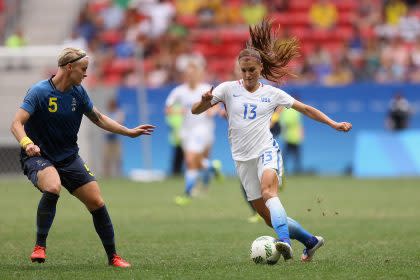Why U.S. women's national team superstar Alex Morgan is moving to France

The first repercussion of the apparent collective bargaining agreement stalemate between U.S. Soccer and its women’s national team arrived on Tuesday when superstar striker Alex Morgan announced that she’ll be spending the first half of 2017 with Olympique Lyon in France.
She finally signs after club chairman Jean-Michel Aulas, who turned the club’s men’s team into a powerhouse and has done much the same for the women’s side, creepily recruited Morgan on Twitter for more than a year.
But the only reason that she is capable of leaving the National Women’s Soccer League, where she starred for the Orlando Pride in its inaugural season as the biggest draw in the league in 2016, is that the women’s national team and U.S. Soccer have an expiring collective bargaining agreement. Or, if you want to be pedantic, an expiring memorandum of understanding to an already-expired collective bargaining agreement. The CBA, after all, requires women’s national teamers to play at home in the NWSL because – and here’s where it gets a tad complicated – their six-figure national team salaries include $56,000 to play for their league clubs. That was the 2016 figure, anyway.
But with the MOA to the CBA running out Dec. 31 and no agreement on a new deal apparently in sight in an increasingly ugly fight over equal pay with the men’s team, Morgan is free to play overseas.
Lyon is the preeminent women’s team in Europe, and quite possibly the world. When fellow national team star Megan Rapinoe played there in 2013 and 2014, she earned $14,000 a month – a salary not paid anywhere else in the women’s game.
According to a statement by an “obviously disappointed” Pride, the 27-year-old Morgan will return after the European season concludes in May or early June, meaning she’ll miss a month or two of the six-month NWSL season.
The question, of course, is why?
Morgan is a big star here, making many multiples of her soccer earnings in endorsements – reportedly pushing her income well into seven figures – but those opportunities will obviously by hampered by distance, even if Morgan will be back whenever the national team plays.

It also leads you to wonder just how far off a CBA agreement really is, a process in which Morgan is heavily involved as a key player on the national team. It stands to reason that any deals signed by players before a new CBA is agreed and ratified will be grandfathered in. But if one were close, the federation would surely insist that none of the big American stars miss any of the season in a league that’s almost entirely underwritten by U.S. Soccer and which badly needs the star power.
Perhaps signing in Europe, as several other national teamers very might do as well, is a hedge. Something to protect them against possible unemployment if negotiations drag far into the new year, which probably won’t really get going until a potential second SheBelieves Cup in March.
“This was not an easy decision for me,” Morgan wrote on the Players’ Tribune. “I know that our U.S. women’s national team is in a critical place at the moment, as we fight for what’s fair in a new CBA, and that it will be more difficult for me to help lead from abroad. I know, too, that the Pride and our incredible fans will be opening a state-of-the-art new stadium without me, and that I will miss the early part of the season. All of those things made it very difficult for me to make this decision.”
“My motivation is pretty simple,” Morgan continued. “I hope that this change will help push my game to another level. I hope that training with these incredible athletes each day, and learning a unique style of play, is exactly what I need, and that it will help me find that next gear. Importantly, I will also be immersed in a soccer culture that I believe is precisely what I need at this point in my career. It has always been a dream of mine to ‘live’ soccer and to compete in the Champions League.”
The pursuit of a new challenge is valid reasoning, although you could argue that after the Pride’s 6-13-1 inaugural season, good for second-to-last place, in which Morgan scored a mere four goals in 15 appearances, there’s plenty to be accomplished stateside.
But then a fresh environment might do Morgan some good. After losing much of 2014 and a part of 2013 to a pesky ankle injury, she returned to scoring at a prolific clip for the U.S. in a Women’s World Cup-winning 2015 and 2016, getting a combined 35 goals in 43 games. But there’s a sense that she hasn’t been quite as dominant as she was in 2012, her best year yet, when she got a staggering 27 goals in 31 games, including several key tallies in the run to the 2012 Olympic gold medal. Granted, the national team played a style that suited her blazing speed and off-the-shoulder runs better then.
Above all, Morgan felt like she had to take risks.
“To get to this level, you have to have a great deal of inner drive,” she wrote. “And sometimes that drive just takes over. When it does, you need to go with it, or risk losing the very thing that helped to make you great. I’m 27 years old. I’m in my prime right now. But my prime isn’t going to last forever. I’m not looking to coast. Just going through the motions isn’t something I’ll ever be comfortable with. I have big goals. I want to be the best player in the United States … the best player in the world. So … I’ve decided to take a huge risk and bet on myself.”
Leander Schaerlaeckens is a soccer columnist for Yahoo Sports. Follow him on Twitter @LeanderAlphabet.



